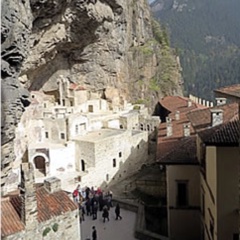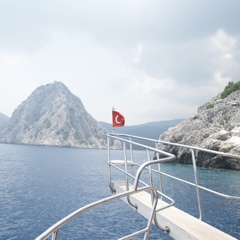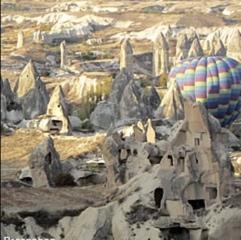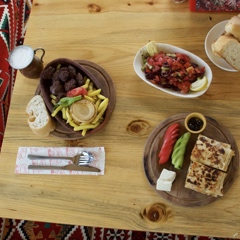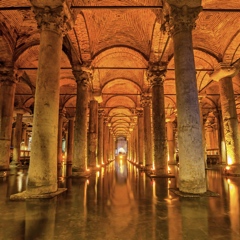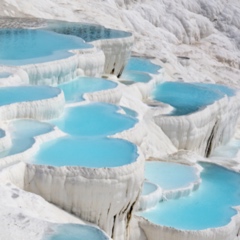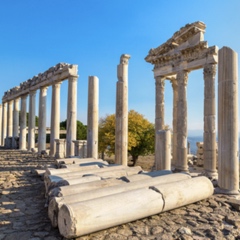Here's an article I published in Travel & Leisure magazine:
HAGIA SOPHIA:
THE PERFECT SPACE
Drafty, sombre, aged, dank, lofty, glorious. In summer cool as marble, in winter cold as snow.
On a hot Istanbul afternoon, Hagia Sophia is an oasis of cool silence broken only by the spiel and patter of the multilingual guides. Their flocks of curious Europeans, Americans, Japanese and Greeks feel what the guides by this time ignore: awe. It is the awe not of religion, for Hagia Sophia is neither church nor mosque any longer. The awe is of age, of history, and of miraculous architecture.
Hagia Sophia is an experience in space and time, and the architects' magic still works after more than fourteen centuries.
Here, for the first time, the basilica's classic rectangle was widened to a square and topped with an immense flattened dome. So ambitious were the architects, Anthemius of Tralles and Isidorus of Miletus, that the dome had to be made from special hollowed bricks shaped from a particularly light clay found only on the island of Rhodes.
The huge pillars which support the dome are effectively hidden in the north and south walls of the nave.
After the conquest of Constantinople in 1453, this design influenced the basic plan of the greatest, most splendid Ottoman Turkish mosques.
Stroll into Hagia Sophia's shady garden and you feel only that you are approaching an improbable, famous, old, ungainly pile of Byzantine masonry, huge and squat, guarded by four dissimilar and incongruous minarets. Its harmonious original form is now dissonant with extra buttresses at north and south.
At the end of the path you turn to the right and approach the entrance, and everything changes. Through the severe but stately rectangle of the first door you see a second door, and a third, and then a great space beyond. Enter at the measured pace of a religious procession, and Hagia Sophia reveals her secrets, one by one.
In the dim light deep within is a glimmer of gold. Your eyes adjust to the darkness and you recognize the apse blazing with a glorious gold mosaic of Madonna and Child. A few more steps, and the vision is clear and beautiful.
Look up now: above the great innermost door once reserved for the emperor another mosaic appears, a figure in rich array with hand raised in benediction. Approach, and the face becomes visible: it is Christ Pantocrator, Ruler of All, the lifelike face full of power and majesty.
Another step, and the distant apse has been dwarfed by the huge dome above it. No! It is only a semi-dome, with a circle of windows swimming into view high above. A few steps more and you stand at the Imperial Door, and finally the last secret is revealed as the enormous gilded dome soars above the vast inner space of the nave, the small windows at its base lifting it with colored light.
On the 26th of December, A.D. 537, Emperor Justinian the Great stood in the Imperial Door, gazed at the cathedral which he had built, and exclaimed, "Glory to God that I have been judged worthy of such a work. Oh Solomon! I have outdone thee!"
At this same spot on May 29, 1453, almost a thousand years later, Sultan Mehmet the Conqueror, fresh from the final battle for Constantinople, stood in this doorway and ordered the great church to be cleansed, repaired, beautified, and converted to a mosque.
Another five centuries, and it was proclaimed a museum by Kemal Atatürk (1934) and opened to all.
Repairs are under way yet again, but scaffolding is temporary, the great church eternal.
I try to imagine how it must have looked with its hundreds of tiny oil lamps aflame, the drone of Orthodox chant and the scrape of measured steps rising to heaven on clouds of incense. I picture legions of the Muslim faithful in ritual prayer, their genuflexions in perfect unison, their voices rising and echoing in the perfect acoustics.
Outside is modern Istanbul, hot and busy with buses and postcard hawkers, with children playing in a fountain and businessmen talking on mobile phones.
In Hagia Sophia, ghosts of the great empires seek refuge in the cool, sombre air, and I am there with them.
(Copyright © 1989 by Tom Brosnahan. All rights reserved.)
| Articles by Tom Brosnahan |




